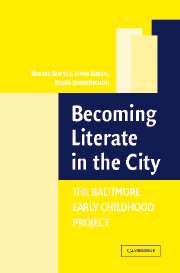Book contents
- Frontmatter
- Contents
- Preface
- 1 Early Appropriation of Literacy in Sociocultural Context
- 2 Growing Up in Baltimore : The Early Childhood Project
- 3 The Intimate Culture of Children's Homes
- 4 Processes of Literacy Enculturation in the Home
- 5 The Development of Literacy Competencies and Orientations
- 6 The Agenda and Practices of Schooling
- 7 Relations Between Homes and Schools
- 8 Conclusions and Implications for Policy and Practice
- References
- Name Index
- Subject Index
3 - The Intimate Culture of Children's Homes
Published online by Cambridge University Press: 17 December 2010
- Frontmatter
- Contents
- Preface
- 1 Early Appropriation of Literacy in Sociocultural Context
- 2 Growing Up in Baltimore : The Early Childhood Project
- 3 The Intimate Culture of Children's Homes
- 4 Processes of Literacy Enculturation in the Home
- 5 The Development of Literacy Competencies and Orientations
- 6 The Agenda and Practices of Schooling
- 7 Relations Between Homes and Schools
- 8 Conclusions and Implications for Policy and Practice
- References
- Name Index
- Subject Index
Summary
In this chapter, we describe the recurrent, literacy-related activities reported and observed within the homes of the children we studied in Baltimore, and we identify some salient organizing themes around which those activities were interpreted by their participants. Our description of the intimate culture of family homes in Baltimore brings together findings collected with several of the instruments described in Chapter 2. We adopted two complementary approaches in our interviews with parents over the years: a relatively objective, ecological inventory that generated quantitative indices of the frequency of various types of activity; and a more interpretive exploration of the meanings informing the patterns of activity reported. This exploration was designed to reveal the parent's implicit theory of child development and socialization. The chapter begins with a theoretical orientation to the concept of intimate culture and then offers an account of our findings, starting with a survey of the patterns of child engagement in recurrent activities, followed by an examination of the parents' socialization goals, and beliefs about the best strategies for achieving them, as these were expressed to us in the parental ethnotheory interviews. Next we discuss family routines, based on our adaptation of scales designed by Fiese and her colleagues (Fiese, Hooker, Kotary, & Schwagler, 1993; Fiese & Kline, 1993; Sameroff & Fiese, 1992). At the end of the chapter, we present a synthesis of several indices of intimate culture that have proven to be highly predictive of literacy appropriation in our sample – namely, the family's relative emphasis on two contrasting cultural themes about the nature of literacy socialization.
- Type
- Chapter
- Information
- Becoming Literate in the CityThe Baltimore Early Childhood Project, pp. 64 - 102Publisher: Cambridge University PressPrint publication year: 1958



